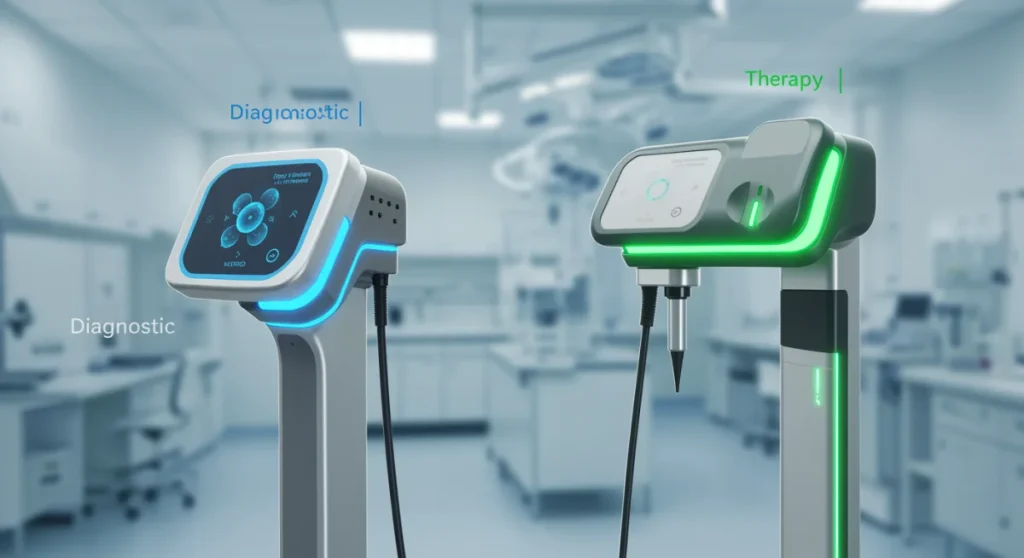FDA Approves 2 New Breakthrough Medical Devices by Mid-2025

The FDA has granted approval to two innovative medical devices, anticipated to be available by mid-2025, promising significant advancements in diagnostic and therapeutic capabilities for various medical conditions.
The landscape of modern medicine is constantly evolving, driven by relentless innovation and a commitment to improving patient outcomes. This commitment recently culminated in a significant milestone: the FDA approves 2 new breakthrough medical devices, expected to reach market by mid-2025. These approvals represent not just regulatory clearances but a beacon of hope for patients and a testament to the scientific ingenuity pushing the boundaries of healthcare.
Understanding FDA breakthrough device designation
The FDA’s breakthrough device program is designed to expedite the review of certain medical devices and device-led combination products that provide more effective treatment or diagnosis of life-threatening or irreversibly debilitating diseases or conditions. This designation is crucial for bringing truly innovative solutions to patients faster.
It’s a rigorous process, emphasizing early and frequent communication with the FDA, but it ensures that only the most promising technologies receive this accelerated pathway. The goal is to get essential tools into the hands of healthcare providers and patients who need them most, without compromising safety or efficacy.
The pathway to approval
For a device to receive breakthrough designation, it must meet specific criteria. It needs to offer a significant advantage over existing approved or cleared alternatives, or address an unmet medical need. This often involves novel technologies or significant improvements to current standards of care.
- Early engagement: Manufacturers engage with the FDA early in the development process.
- Expedited review: Priority review is given to breakthrough devices.
- Patient access: Aimed at faster patient access to life-saving technologies.
- Rigorous standards: Despite acceleration, safety and effectiveness remain paramount.
The breakthrough designation isn’t a guarantee of approval, but it streamlines the journey, providing manufacturers with invaluable guidance and support from the regulatory body. This collaborative approach helps identify potential issues early and ensures that all necessary data is collected efficiently.
Ultimately, the breakthrough device program reflects the FDA’s dedication to fostering innovation while protecting public health. The recent approvals highlight the success of this program in identifying and fast-tracking truly transformative medical technologies that promise to reshape treatment paradigms.
Device one: revolutionizing early cancer detection
Among the two newly approved devices, one stands out for its potential to transform early cancer detection. This device employs a novel non-invasive methodology that promises to identify cancerous cells at a much earlier stage than currently possible, significantly improving prognosis and treatment efficacy.
Early detection has long been the holy grail in oncology, offering the best chance for successful intervention. This new technology moves us closer to that ideal, providing a tool that is both highly sensitive and specific, minimizing false positives and negatives.
Advanced diagnostic capabilities
The first approved device leverages advanced artificial intelligence and machine learning algorithms to analyze biomarkers with unprecedented precision. Unlike traditional screening methods that might miss subtle indicators, this device can detect minute changes that signify the presence of cancer.
- Non-invasive screening: Reduces patient discomfort and increases compliance.
- High sensitivity: Detects cancer at its earliest, most treatable stages.
- AI-powered analysis: Enhances accuracy and speeds up diagnostic processes.
- Broader applicability: Potentially applicable across various cancer types.
The implications of such a device are profound. Imagine a future where routine screenings can reliably catch cancer before symptoms even appear, allowing for interventions that are less aggressive and more successful. This could drastically reduce cancer-related mortality rates.
The development involved extensive clinical trials, demonstrating not only its effectiveness but also its safety profile. Patients participating in the trials experienced minimal side effects, further solidifying its potential as a game-changer in cancer diagnostics. This device represents a monumental leap forward in our fight against cancer.
Device two: a new era for neurological disorder treatment
The second FDA-approved breakthrough device targets neurological disorders, offering a novel therapeutic approach that promises to significantly alleviate symptoms and improve the quality of life for millions. This device represents a paradigm shift in how certain chronic neurological conditions are managed.
Neurological disorders often present complex challenges, with many conditions lacking effective long-term treatments. This new device introduces a targeted intervention that can modulate neural activity in a way previously thought impossible, opening new avenues for therapy.
Targeted neural modulation
This innovative device utilizes highly focused, non-invasive stimulation to precisely target specific regions of the brain or nervous system. It works by gently influencing neural pathways, providing relief from symptoms such as chronic pain, tremors, and severe depression that have been resistant to conventional treatments.
The precision of this technology is one of its most remarkable features. Unlike broader treatments, it can be calibrated to address the unique neurological patterns of each patient, leading to highly personalized and effective therapeutic outcomes. This level of customization is a significant advancement.


- Non-invasive therapy: Avoids surgical risks and recovery times.
- Personalized treatment: Tailored to individual patient neurological profiles.
- Symptom alleviation: Offers significant relief for chronic and debilitating conditions.
- Improved quality of life: Enables patients to regain functional independence.
Clinical trials for this device have shown remarkable success in reducing the severity and frequency of symptoms in patients who had previously exhausted other treatment options. The data points to a future where neurological disorders are not just managed but significantly ameliorated, offering renewed hope for a better life.
The development team focused heavily on user-friendliness and patient comfort, ensuring that the device is not only effective but also easy to integrate into a patient’s daily routine. This holistic approach makes it a truly patient-centric innovation.
Economic and societal impact of new approvals
The FDA’s approval of these two breakthrough medical devices carries significant economic and societal implications. Beyond the direct health benefits for patients, these innovations are poised to stimulate economic growth, create new job opportunities, and potentially reduce long-term healthcare costs by improving preventative care and treatment efficacy.
The medical device industry is a major economic driver, and these new products will undoubtedly contribute to its expansion. The development, manufacturing, and distribution of these devices will require a skilled workforce, spanning research, engineering, production, and clinical support.
Boosting healthcare infrastructure
The integration of these advanced devices into existing healthcare systems will necessitate upgrades and training, further investing in infrastructure and human capital. Hospitals and clinics will need to adapt to incorporate these technologies, leading to a more technologically advanced healthcare landscape.
- Job creation: New roles in R&D, manufacturing, and clinical application.
- Economic growth: Increased investment in the medical technology sector.
- Reduced healthcare burden: Early detection and effective treatment can lower long-term costs.
- Enhanced global competitiveness: Positions the U.S. at the forefront of medical innovation.
From a societal perspective, the ability to detect cancer earlier and more effectively treat neurological disorders will not only extend lives but also improve their quality. This means more productive years for individuals, reduced strain on caregivers, and a healthier overall population.
These approvals reinforce the value of investing in medical research and development. They demonstrate that groundbreaking science, when supported by robust regulatory pathways, can translate into tangible benefits for society. The ripple effect of these innovations will be felt across various sectors.
Challenges and opportunities ahead
While the approval of these two breakthrough medical devices is a cause for celebration, the journey from approval to widespread patient access comes with its own set of challenges and opportunities. Ensuring equitable access, managing integration into diverse healthcare systems, and continuing post-market surveillance are critical next steps.
The rapid pace of technological advancement often outstrips the speed at which healthcare systems can adapt. Therefore, careful planning and collaboration between manufacturers, healthcare providers, and policymakers will be essential to maximize the impact of these new devices.
Navigating market entry and adoption
Bringing these devices to market by mid-2025 will involve more than just manufacturing. It requires comprehensive training for medical professionals, development of new clinical protocols, and strategies to ensure affordability and reimbursement. Overcoming these hurdles will be key to successful adoption.
- Healthcare provider training: Ensuring proper use and integration.
- Reimbursement policies: Establishing fair pricing and coverage.
- Patient education: Informing the public about new treatment options.
- Post-market surveillance: Continued monitoring for long-term safety and efficacy.
The opportunities, however, far outweigh the challenges. These devices have the potential to set new standards of care, inspiring further research and development in their respective fields. They could serve as blueprints for future innovations, fostering a virtuous cycle of scientific progress.
Furthermore, their success could pave the way for more breakthrough designations and approvals, encouraging companies to invest in high-risk, high-reward research. The lessons learned from the development and deployment of these devices will be invaluable for future medical advancements.
The future of medical technology and patient care
The recent FDA approvals are a strong indicator of the direction medical technology is heading: towards precision, personalization, and proactive care. These devices embody the convergence of advanced engineering, artificial intelligence, and deep medical understanding, setting a new benchmark for future innovations.
The emphasis on early detection and targeted, non-invasive therapies reflects a broader shift in healthcare philosophy, moving from reactive treatment of advanced disease to preventative and minimally invasive interventions. This approach promises not only better outcomes but also a more humane patient experience.
Looking beyond 2025
As these devices become integrated into clinical practice, their real-world impact will undoubtedly generate new insights and inspire subsequent generations of medical technologies. We can anticipate even more sophisticated tools emerging, further refining diagnostics and therapeutics.
- Enhanced personalization: Treatments tailored to individual genetic and physiological profiles.
- Miniaturization: Smaller, more portable, and less invasive devices.
- Integration with AI: Smarter devices capable of autonomous analysis and intervention.
- Global health impact: Potential to address health disparities worldwide.
The mid-2025 market entry marks just the beginning of their journey. The long-term data collected from their use will be instrumental in validating their sustained benefits and identifying new applications. This continuous cycle of innovation, deployment, and evaluation is vital for true progress in medicine.
These breakthrough devices are not just products; they are symbols of hope and progress. They remind us that human ingenuity, coupled with rigorous scientific inquiry and regulatory oversight, can overcome some of the most daunting health challenges, paving the way for a healthier future for all.
| Key Point | Brief Description |
|---|---|
| FDA Breakthrough Approval | Two innovative medical devices received expedited FDA approval for life-threatening conditions. |
| Early Cancer Detection Device | A non-invasive, AI-powered diagnostic tool for highly sensitive early cancer detection. |
| Neurological Treatment Device | A targeted, non-invasive therapy for managing chronic neurological disorders effectively. |
| Market Availability | Both devices are projected to be available for patient use by mid-2025, transforming care. |
Frequently asked questions about new medical device approvals
The FDA breakthrough device designation expedites the review process for medical devices that offer more effective treatment or diagnosis of life-threatening or irreversibly debilitating conditions. It aims to provide patients with faster access to groundbreaking technologies that address significant unmet medical needs, while maintaining rigorous safety and efficacy standards.
One device is designed for the early detection of various cancers, utilizing non-invasive methods and advanced AI for highly sensitive and specific results. The second device focuses on neurological disorders, offering a novel, targeted therapeutic approach to alleviate symptoms and improve the quality of life for patients with chronic conditions.
Both newly approved medical devices are anticipated to reach the market and become available for clinical use by mid-2025. This timeline reflects the expedited nature of their breakthrough designation, aiming to bring these critical innovations to patients as quickly as possible following regulatory clearance.
These devices are expected to significantly improve patient care by enabling earlier and more accurate cancer diagnoses, leading to better treatment outcomes. For neurological disorders, they offer new hope for symptom relief and enhanced quality of life through targeted, non-invasive therapies, filling critical gaps in current treatment options.
The approvals are projected to stimulate economic growth within the medical technology sector, creating new jobs in research, manufacturing, and healthcare. They may also lead to long-term reductions in healthcare costs by fostering preventative care and more effective treatments, ultimately enhancing overall societal health and productivity.
Conclusion
The recent announcement that the FDA has approved two new breakthrough medical devices, with an expected market release by mid-2025, marks a pivotal moment in healthcare. These innovations, one for early cancer detection and the other for neurological disorder treatment, underscore the power of scientific advancement and regulatory foresight. They promise to profoundly impact patient lives, offering new hope and improved outcomes for conditions that have long posed significant challenges. As these devices transition from approval to widespread clinical use, they will not only transform individual patient care but also catalyze further research and development, solidifying a future where precision, personalization, and proactive medicine lead the way.





